A BRIGHT FUTURE
As Good As It Gets
You might think that writing about good weather would tempt the fates. I’ll thumb my nose at the fates and go ahead and write that this spring is the best spring, gardenwise, ever in all the decades since I’ve been gardening. The flowers have been more vibrant with color and, it seems, also in greater profusion. The air has been particularly fragrant, especially now with the intoxicating aroma of black locust blooms following closely on the heels of autumn olive’s sweet scent.
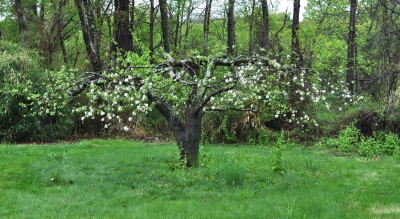
My fruit trees are most thankful for this spring’s beneficence. In all the years of growing fruit here on the farmden, never has the landscape been so brightened by snowballs of white blooms of plum and pear trees, pinkish blossoms of apples, and peaches’ pure pink blossoms.
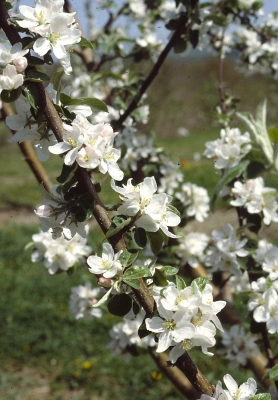

The now-fallen petals are no cause for wistfulness, because those clusters of flowers have now morphed into clusters of fruits
Why this Year?
What makes for such a glorious spring? The weather, of course, both this spring’s in addition to last winter’s and even last spring’s. Let’s first go back to last spring’s weather effects.
During spring 2020 the weather warmed going into April, coaxing flower buds on fruit trees to swell. Then, towards the end of that month and into May, a number of nights saw temperatures that nipped life from many flowers, then open, especially the 22° temperature on April 23rd and then subfreezing temperatures on May 9th, 13th, and 14th. (All this information handily recorded and passed onto my computer via Sensorpush sensors I have at two locations outdoors and one location in the greenhouse.)
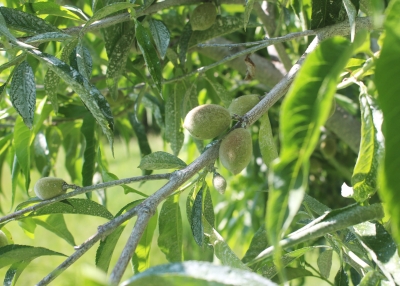
Prelude to the present season began with a relatively mild winter, for which peach flower buds, which suffer damage at around minus 15°, were especially appreciative. And this spring has seen more or less gradually warming temperatures with — and this is most important — no late, damaging frosts. Buds for a current spring’s blossoms develop the summer of the previous year. Seeds in developing fruits produce a hormone that suppresses flower bud formation, so a heavy crop one year means a lighter crop the following year, and vice versa, all other things being equal. Last year’s late frosts knocked out much of the potential fruit crop so this year the trees did what they do, compensating for last year’s loss with more blooms.
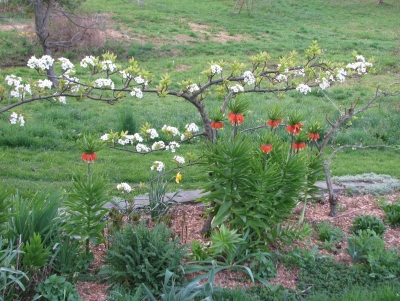
Fruit trees can afford to lose a certain number of flowers to cold each year. For instance, each flower bud of an apple tree unfolds to five flowers, and only 5 percent of those flowers need to set fruit for a full crop of apples. Furthermore, a temperature below 32° doesn’t always cause damage; just how much damage ensues depends on the the growth stage of flower buds and how cold it gets. Using apples, again, as an example, when their buds have expanded just enough to hint at the five flowers within (the “tight cluster” stage), 27° will kill 10 percent of them, 21° will kill 90 percent of them. More details for apples and other fruits can be found here.
Another variable is that temperatures can vary a little at various points within a tree, which can be important at these critical temperatures.
Not Yet Home Free
This auspicious spring is not a call for me to just sit back and wait for the delicious bounty to hang on the branches awaiting my picking. My work is cut out for me.
One job, to begin soon, will be thinning the fruit, that is, removing lots of them. In addition to upping the chances for a good return bloom and harvest next year (remember the seeds and the hormones), fruit thinning lets the trees channel more of their energy resources into fewer fruits. The result: Fruits that remain are larger and more flavorful. Fruit thinning also lessens the chance of limbs breaking under the the load of too many fruits, and lessens pest problems. Two apples touching each other provide good cover for the larvae of codling moths to burrow into the fruits to become the classic “worm in the apple.”
 Commercially, tree fruits are thinned with chemical sprays but I’ll be thinning by hand. The plan is to reduce the number of fruits to one per bud, leaving the largest and most pest-free, and allowing remaining fruits to sit no closer than about a half a foot apart along branches. Larger kinds of fruits are the ones that need thinning, which is nice because it would be very tedious to thin small fruits, such as cherries. Winter pruning removes some branches with fruit buds, so also contributes to reducing the load, as does trees’ natural shedding of some excess fruits.
Commercially, tree fruits are thinned with chemical sprays but I’ll be thinning by hand. The plan is to reduce the number of fruits to one per bud, leaving the largest and most pest-free, and allowing remaining fruits to sit no closer than about a half a foot apart along branches. Larger kinds of fruits are the ones that need thinning, which is nice because it would be very tedious to thin small fruits, such as cherries. Winter pruning removes some branches with fruit buds, so also contributes to reducing the load, as does trees’ natural shedding of some excess fruits.
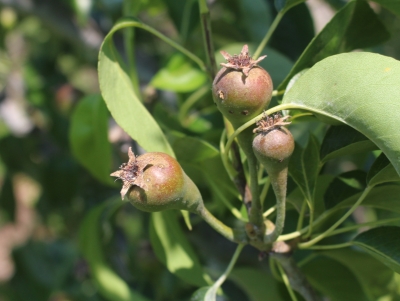
Another job, which began a few weeks ago, is keeping an eye out for and protecting fruits from insects and diseases — particularly problematic on a less than perfect site such as here on the farmden. All of the common tree fruits, except for pear, are very prone to these problems throughout much of eastern North America.
On a backyard scale, the problems are few but serious, in some cases serious enough to eliminate almost the whole crop or render it inedible. The major culprits are plum curculio, codling moth, apple maggot, oriental fruit moth, brown rot, apple scab, fire blight, and cedar apple rust. Not to mention deer and squirrels.
My tack is to take a multi-pronged approach, with some spraying (mostly organic), nurturing the soil (lots of mulch and compost) and the plants (pruning and fruit thinning), fostering beneficial insects with plantings that encourage their presence and with careful choice and limited amount of sprays, trapping pests (hanging fake apples, Red Delicious, with sticky Tanglefoot in trees), and possibly bagging individual fruits. See Grow Fruit Naturally for more about these approaches.
Even if there is “many a slip ‘twixt the cup and the lip,” every fruit grower has to be an optimist.
Plant Sale Reminder
This is the last week of my annual plant sale. For more information, go to https://leereich.com/2021/05/last-week-of-2021-plant-sale.html
And, A Free Webinar, “Weedless Gardening”
For more information, go to www.leereich.com/workshops.



Very interesting! I didn’t know that the volume of fruit alternated year to year, all other things being equal.
The unremarkable blossoms of the blackcurrant bush give off, nonetheless, such a fragrant scent, and I was blessed to be intoxicated by our bush every time I brushed past it going in or out my door this spring. It felt like a benediction after such a hard year. And now there are tons of developing berries, unlike last year. Can’t wait! A little netting, a little patience and luck –
That alternate bearing is more of a tendency for some kinids and varieties of fruits than for others.
I also love the aroma (and flavor) of black currants. Not eferyone feels this way. When I was working with a Russian translator for some of the literature research for my book about uncommon fruits, she told me that they don’t like the aroma in Russia. To them, the smell is reminiscent of bedbugs. (Fortunately, I wouldn’t know.)
I’ve never netted my black currants, and nothing ever ate the berries, except me.
Yes, they have a particular taste for sure – not for everyone. I love ’em in my winter oatmeal, among other things.
I pruned the deadwood a couple of years ago – maybe that is supporting a plentiful harvest?
I have lost many berries to birds and chipmunks, even with a dog or two around, so have learned to net. Luckily the bush is so close to the house, it hasn’t attracted bears. No, the dog doesn’t always keep the bears away, depending on other conditions, like first spring hunger, number of cubs, plenty or lack of other food in any particular year, loss of fear of humans from careless disposal of garbage and so on.
My neighbor who sees massage clients at home, chose to cut down her beautiful chokecherry trees – the bears were climbing in them and scaring the clients away.
Lee, I have to add the rose chafer to your pest list: here in Jay, NY zone 4b, those darn beetles LOVE my plum trees, as well as my grapes. They don’t touch the Rugosas!
Wow, I never knew the chafers had such cosmopolitan taste.
In northern NJ we have to wrap our black currant with agribon (as well as our blueberries) or we never get to eat a single berry. But this year the plants are absolutely laden with fruit so it’s well worth doing! Happy to see a drastic reduction in squirrels and chipmunks this year due to the low acorn production last fall of the oaks – perhaps we won’t have to compete with them for raspberries and grapes unlike last year which was especially maddening. At least they don’t bother my citrus trees!
Outdoor cats and dogs are a big help with squirrels and chipmunks.
Thanks for your observations Lee. Yes, this is definitely a seed year as opposed to last years foliage year. One of the ways to see this is by looking at our sugar maple trees which are absolutely loaded with seeds. Same with fruit trees. In my neck of the woods (SW NH) we had a moderate to severe drought last summer which stressed the trees enough to kick them into survival/reproduction mode which translates into this year being a seed year.
Good news….many more fruits this year. Not so good news……fall foliage is never as vibrant in heavy seed years.
I never knew cause and effect to be so simple in nature.
I’m glad you have had such fine spring weather. Twas not the case in central Indiana. We had temps in the mid-20’s on April 21 which ruined my hopes for pears, paw paws, and kiwis. I wonder if hardy kiwi will ever produce where I live. I have had my plants for eight years, two females and a male. In that time I only had a crop once, a dozen fruit. I am questioning if I should get rid of them since spring cold snaps seem to be the norm here.
My fruits that were not affected by the cold are elderberry, grape, goji, and aronia.
Sorry about you weather. Interesting than I live in the bottom of a valley, which is generally bad as far as late frosts, but I do usually get at least some pears and almost always grapes and kiwis and pawpaws. I don’t care for elderberry, aronia, or goji.
Hi Lee! Lovely post.
You reference doing a little spraying as needed….On a somewhat different topic, can you recommend a combination fungal product for powdery mildew (for echinaceas, rudbeckias and monardas)?
I wouldn’t bother them because the powdery mildew usually causes mostly cosmetic damage to them. But if you want to spray, a spray of 3 tablespoons of horticultural oil to a gallon of water with 3 tablespoons of potassium bicarbonate or baking soda (sodium bicarbonate) is supposed to be effective. Sulfur is also effective.
Lee, I have been in inconsistent contact with you about transplanting paw paw suckers that shot up away from the main tree. Well, I’ve gotten one to grow for me (which is more than I can say about the named variety that didn’t make it– an expensive mistake)! I am treating it like a seedling pawpaw, that is, it is out of direct sunlight, and thus a bit sheltered from the other elements. It seems to be responding well, any other pointers? Can I expect fruit any time soon, or is a sucker more like a tree started from seed than a graft?
Also, the next time I do buy a grafted pawpaw, will that tree need to stay out of the sun if it is three feet tall?
Thanks
A grafted tree should not need to be shaded. The graft is mature wood. Seedlings, which do need shade, have to go through “puberty” before they are mature. Typically, trees start fruiting when 5-6 feet tall, at least in my experience and reports of other.